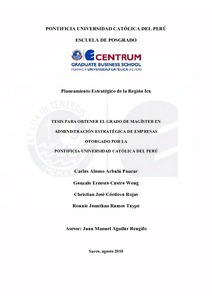| dc.contributor.advisor | Aguilar Rengifo, Juan Manuel | |
| dc.contributor.author | Arbulú Paucar, Carlos Alonso | es_ES |
| dc.contributor.author | Castro Wong, Gonzalo Ernesto | es_ES |
| dc.contributor.author | Córdova Rojas, Christian José | es_ES |
| dc.contributor.author | Ramos Taype, Ronnie Jonathan | es_ES |
| dc.date.accessioned | 2018-09-13T21:24:19Z | |
| dc.date.available | 2018-09-13T21:24:19Z | |
| dc.date.created | 2018 | |
| dc.date.issued | 2018-09-13 | |
| dc.identifier.uri | http://hdl.handle.net/20.500.12404/12637 | |
| dc.description.abstract | Ica es una de las regiones peruanas con mayor crecimiento y desarrollo en los últimos
30 años. Los indicadores económicos, sociales, demográficos y culturales lo demuestran. De
la misma manera la Región Ica busca que esta bonanza se mantenga en el futuro y que el
crecimiento siga igual de sostenido o incluso sea mayor. Para lograr esto, la Región Ica se ha
basado en 4 pilares económicos fundamentales: (1) la industria extractiva a través del gas
licuado de petróleo que viene de la Región Cusco y del hierro que es extraído de Marcona;
(2) la industria de la manufactura que recae en la exportación agroindustrial y de prendas de
algodón; (3) la industria agropecuaria que lidera el país con productos como el espárrago, la
palta, uva, mangos, arándanos, entre muchos otros; (4) finalmente, la pesquería, que está
fortalecida por el aporte en harinas y conservas de pescado.
El objetivo del presente plan estratégico es determinar la situación actual de la Región
Ica y cuál será su situación en 10 años (Propuesta 2027), y en base a este diagnóstico poder
establecer objetivos a largo plazo y que a través de estrategias claras y medibles se pueda
llegar a esta situación futura esperada. La región Ica se encuentra ubicada estratégicamente en
el centro de la costa peruana con salida al mar, con una población con mano de obra
calificada y semi calificada atractiva para el inversionista; cercanía vía terrestre con Lima y
muy pronto con toda la nación e incluso internacionalmente con la construcción del
aeropuerto internacional de Pisco; tierras agrícolas muy fértiles a pesar de encontrarse en el
desierto con tecnología de riego moderna; excelente clima todo el año, entre muchas otras
fortalezas. La propuesta del plan estratégico será potenciar aquellas industrias en las que Ica
es líder y que son las más rentables como la exportación de espárrago y palta, pero también
activar (bajo un sustento de rentabilidad) la industria del turismo, sobre todo el de aventura en
la región, el cual no sólo es muy rentable, sino que traerá beneficio sostenible a toda la
región. | es_ES |
| dc.description.abstract | Ica is one of the Peruvian regions with the highest growth and development in the last
30 years. The economic, social, demographic and cultural indicators prove it. In the same
way the Ica region seeks that this bonanza is sustainable in the future and that growth
continues in a sustained way or even greater. To achieve this, the Ica region has been based
on 4 fundamental economic pillars: (1) The extractive industry through the liquefied
petroleum gas that comes from the Cusco region and the iron extracted from Marcona. (2)
The manufacturing industry that relies on the agroindustry exports and cotton garments. (3)
The agricultural industry that leads the country with products such as asparagus, avocado,
grapes, mangoes, blueberries, among many others. (4) Finally, the fishery, which is
strengthened by the contribution in fish flour and canned fish.
The objective of this strategic plan is to determine what is Ica today and how we want
it to be in 10 years (Proposal 2027), and based on this diagnosis or current photo, establish
long-term objectives that through clear and measurable strategies can reach this expected
future situation. The Ica region has everything to make this a reality: it is strategically located
in the center of the Peruvian coast with access to the sea, with a population of skilled and
semi-skilled labor attractive to investors, close by land to Lima and very soon with the whole
nation and even internationally with the construction of the international airport of Pisco,
very fertile agricultural land despite being in the desert with modern irrigation technology,
excellent weather all year round, among many other fortresses. The proposal of the strategic
plan will be to promote those industries of which we are leaders and which are the most
profitable as the export of asparagus and avocado, but also activate (under a profitability
rationale) the tourism industry, especially the adventure tourism in our region, which is not
only very profitable but will bring sustainable benefit to the entire region. | es_ES |
| dc.language.iso | spa | es_ES |
| dc.publisher | Pontificia Universidad Católica del Perú | es_ES |
| dc.rights | info:eu-repo/semantics/openAccess | es_ES |
| dc.rights.uri | http://creativecommons.org/licenses/by-nc-nd/2.5/pe/ | * |
| dc.subject | Planificación regional--Perú--Ica | es_ES |
| dc.subject | Desarrollo regional--Perú--Ica | es_ES |
| dc.subject | Planificación estratégica | es_ES |
| dc.title | Planeamiento estratégico de la región Ica | es_ES |
| dc.type | info:eu-repo/semantics/masterThesis | es_ES |
| thesis.degree.name | Maestro en Administración Estratégica de Empresas | es_ES |
| thesis.degree.level | Maestría | es_ES |
| thesis.degree.grantor | Pontificia Universidad Católica del Perú. CENTRUM | es_ES |
| thesis.degree.discipline | Administración Estratégica de Empresas | es_ES |
| renati.discipline | 413307 | es_ES |
| renati.level | https://purl.org/pe-repo/renati/level#maestro | es_ES |
| renati.type | https://purl.org/pe-repo/renati/type#tesis | es_ES |
| dc.publisher.country | PE | es_ES |
| dc.subject.ocde | https://purl.org/pe-repo/ocde/ford#5.02.04 | es_ES |






